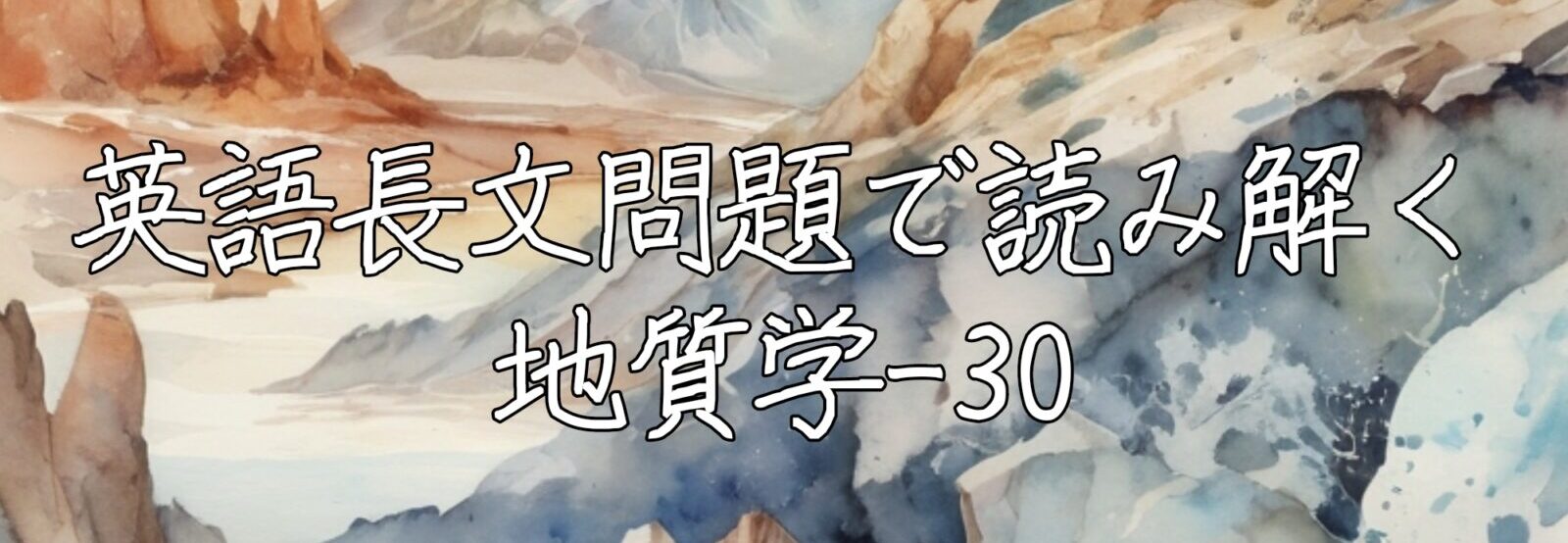英検2級レベルの英語長文問題を読み解きながら、地質学の基本的な知識を身につけることが出来る問題集をkindleにて出版しました!
Amazonプライム会員なら無料で書籍を読むことができます。他にも様々なタイトルを作成しているので、会員の方は、自分好みの問題集を探してみてはいかがでしょうか?

英語長文問題で読み解く地質学-30: 地質学の重要テーマを英語で読み解く 英語長文問題で読み解く学問シリーズ
これまでに発売した英語の長文問題集の一覧はコチラから!
英語長文で読み解く地質学-30 の中身を公開!
以下、どんな内容になっているのかを公開します!
目次
はじめに
1.地質学 – 地球の構造、歴史、物質を研究する学問。
2.鉱物 – 地球の岩石を構成する天然の無機物。
3.岩石 – 鉱物が集まって形成された固体。
4.火成岩 – マグマが冷えて固まってできた岩石。
5.堆積岩 – 堆積物が圧縮されて形成された岩石。
6.変成岩 – 既存の岩石が高温高圧下で変質してできた岩石。
7.プレートテクトニクス – 地球の地殻が複数のプレートに分かれ、それらが移動する理論。
8.リソスフェア – 地球の固い外殻部分で、プレートを構成する。
9.アセノスフェア – リソスフェアの下にあり、柔らかく流動性のある層。
10.地殻 – 地球の最外層で、固体の岩石から成る。
11.核 – 地球の中心部分で、主に鉄とニッケルで構成される。
12.断層 – 地殻の割れ目で、地震の原因となることがある。
13.地層 – 堆積物が層を成して固まったもの。
14.層序学 – 地層の順序や相対年代を研究する学問。
15.鉱床 – 経済的に有用な鉱物が集中している場所。
16.侵食 – 風や水によって岩石や土壌が削られる現象。
17.風化 – 岩石が気候や生物作用によって分解される現象。
18.堆積 – 侵食された物質が水や風によって運ばれ、沈殿すること。
19.プレート境界 – プレート同士が接触し、相互作用を起こす場所。
20.変動帯 – 地殻変動が活発で、山脈が形成される地域。
21.大陸移動説 – 大陸が移動するという理論、現在のプレートテクトニクス理論の基礎。
22.断層帯 – 断層が密集している地域。
23.水文学 – 水の循環、分布、性質を研究する学問。
24.炭素循環 – 地球上の炭素が大気、海洋、生物、地殻を巡るプロセス。
25.鉱物資源 – 経済的価値のある鉱物。
26.地質調査 – 地質構造や資源を調べるための調査。
27.経済地質学 – 経済的に価値のある鉱床の形成と分布を研究する分野。
28.堆積盆地 – 堆積物が多量に蓄積する低地。
29.海洋地質学 – 海洋底や沿岸の地質を研究する分野。
30.地質災害 – 地震、火山噴火、土砂崩れなど、地質に起因する災害。
1.地質学 – 地球の構造、歴史、物質を研究する学問。
The Dynamic Earth: An Introduction to Geology
Geology is the scientific study of the Earth, its structure, composition, and the processes that shape it. This fascinating field helps us understand the planet we call home, from the rocks beneath our feet to the mountains that touch the sky. Geologists are like detectives, piecing together clues from rocks, minerals, and landforms to unravel the Earth’s 4.6-billion-year history.
One of the fundamental concepts in geology is plate tectonics. This theory explains how the Earth’s outer layer, called the lithosphere, is divided into several large plates that move and interact with each other. These plate movements are responsible for many of the Earth’s features and phenomena we observe today. For example, when two plates collide, they can form mountain ranges like the Himalayas. The tallest peak in this range, Mount Everest, continues to grow taller by a few millimeters each year due to this ongoing collision.
Rocks are the building blocks of our planet, and geologists classify them into three main types: igneous, sedimentary, and metamorphic. Igneous rocks form from cooled magma or lava. A common example is basalt, which makes up much of the ocean floor. Sedimentary rocks, like sandstone, form from layers of sediment that are compressed and cemented together over time. Metamorphic rocks, such as marble, are created when existing rocks are subjected to intense heat and pressure, changing their physical and chemical properties.
Geologists also study the Earth’s internal structure. The planet is composed of several layers, including the crust, mantle, and core. The crust is the thin outer layer where we live, ranging from about 5 to 70 kilometers thick. Beneath this is the mantle, a hot, dense layer that makes up about 84% of the Earth’s volume. At the center is the core, divided into a liquid outer core and a solid inner core, which generates the Earth’s magnetic field.
Natural disasters are another important area of geological study. Earthquakes occur when tectonic plates suddenly slip past each other, releasing energy in the form of seismic waves. The San Andreas Fault in California is a well-known example of a fault line where earthquakes frequently occur. Volcanoes, formed when magma erupts through the Earth’s surface, are another geological phenomenon that can have dramatic impacts on the environment and human societies. The eruption of Mount Vesuvius in 79 AD, which buried the ancient Roman city of Pompeii in ash, is a famous historical example of volcanic activity.
Geology also plays a crucial role in understanding climate change. By studying ice cores from glaciers and sediment cores from the ocean floor, geologists can reconstruct past climate conditions and help predict future changes. For instance, analysis of air bubbles trapped in Antarctic ice has revealed how atmospheric carbon dioxide levels have fluctuated over hundreds of thousands of years.
The field of geology has numerous practical applications. Geologists help locate and extract valuable resources like oil, natural gas, and minerals. They also play a vital role in water resource management, identifying aquifers and assessing water quality. In construction, geologists evaluate site stability for large projects like dams and skyscrapers. Additionally, their expertise is crucial in mitigating natural hazards and planning for sustainable development.
As we face global challenges like climate change, resource depletion, and natural disasters, the importance of geology continues to grow. By studying the Earth’s past and present, geologists provide valuable insights that help us prepare for the future and manage our planet’s resources more sustainably.
注釈
- Geology (地質学) – 地球の構造や歴史を研究する科学
- Lithosphere (岩石圏) – 地球の固い外殻
- Plate tectonics (プレートテクトニクス) – 地球の表面が複数のプレートに分かれて動いているという理論
- Igneous rocks (火成岩) – マグマや溶岩が冷えて固まってできた岩石
- Sedimentary rocks (堆積岩) – 堆積物が圧縮されてできた岩石
- Metamorphic rocks (変成岩) – 既存の岩石が熱や圧力で変化してできた岩石
- Crust (地殻) – 地球の最も外側の層
- Mantle (マントル) – 地殻と核の間にある地球内部の層
- Core (核) – 地球の中心部分
- Seismic waves (地震波) – 地震によって発生する波動
- Magma (マグマ) – 地下にある溶けた岩石
- Climate change (気候変動) – 長期的な気候パターンの変化
- Aquifer (帯水層) – 地下水を含む岩石層
設問
- What is the main focus of geology?
a) The study of plants and animals
b) The study of the Earth’s structure and processes
c) The study of the atmosphere
d) The study of ocean currents - Which of the following is NOT a type of rock mentioned in the passage?
a) Igneous
b) Sedimentary
c) Metamorphic
d) Volcanic - What causes the formation of mountain ranges like the Himalayas?
a) Erosion by wind and water
b) Volcanic eruptions
c) Collision of tectonic plates
d) Deposition of sediments - What natural disaster is associated with the San Andreas Fault?
a) Volcanic eruptions
b) Tsunamis
c) Earthquakes
d) Hurricanes - How do geologists study past climate conditions?
a) By analyzing satellite images
b) By examining ice cores and sediment cores
c) By measuring current temperatures
d) By studying ancient texts - Which of the following is NOT mentioned as a practical application of geology?
a) Locating valuable resources
b) Water resource management
c) Evaluating site stability for construction
d) Predicting weather patterns - What percentage of the Earth’s volume does the mantle make up?
a) About 16%
b) About 50%
c) About 67%
d) About 84% - Which ancient city was buried by the eruption of Mount Vesuvius in 79 AD?
a) Rome
b) Athens
c) Pompeii
d) Alexandria - According to the passage, why is the study of geology becoming increasingly important?
a) Because it helps in space exploration
b) Because it improves agricultural techniques
c) Because it addresses global challenges like climate change and resource management
d) Because it enhances our understanding of human history
解答・解説
- 地質学の主な焦点は何ですか?
a) 動植物の研究
b) 地球の構造とプロセスの研究
c) 大気の研究
d) 海流の研究
答え:b
説明:本文の冒頭で、「地質学は地球、その構造、組成、そしてそれを形作るプロセスの科学的研究です」と述べられています。
- 次のうち、本文で言及されていない岩石の種類はどれですか?
a) 火成岩
b) 堆積岩
c) 変成岩
d) 火山岩
答え:d
説明:本文では火成岩、堆積岩、変成岩の3種類の岩石が言及されていますが、火山岩は別途言及されていません。
- ヒマラヤ山脈のような山脈の形成の原因は何ですか?
a) 風や水による浸食
b) 火山噴火
c) テクトニックプレートの衝突
d) 堆積物の沈着
答え:c
説明:本文では、「2つのプレートが衝突すると、ヒマラヤのような山脈を形成することがあります」と述べられています。
- サンアンドレアス断層に関連する自然災害は何ですか?
a) 火山噴火
b) 津波
c) 地震
d) ハリケーン
答え:c
説明:本文では、「カリフォルニアのサンアンドレアス断層は、地震が頻繁に発生する断層線の有名な例です」と述べられています。
- 地質学者はどのように過去の気候条件を研究しますか?
a) 衛星画像を分析することで
b) 氷床コアと堆積物コアを調べることで
c) 現在の気温を測定することで
d) 古代のテキストを研究することで
答え:b
説明:本文によると、「氷河からの氷床コアや海底からの堆積物コアを研究することで、地質学者は過去の気候条件を再構築できます」とあります。
と、このような感じで、30問の長文問題が一冊にまとまっております!
地質学の重要テーマ、30問あります!
目次にもあるように、30個の地質学にまつわる重要テーマやキーワードを使い、長文問題を作りました。
英語力を向上させたい、かつ、地質学の知識を得たい人にとって、最適な長文問題集となっております。
英語レベルは英検2級を目指している人にとって丁度いい塩梅。
Amazonプライム会員なら、無料で読解力を向上させることができるでしょう。音声を読み上げてもらったら、リスニング対策もできそうです!
タイパを重視して、地質学の知識を得つつ、英語の読解力を向上させたい人は、ぜひ活用してみてください。

英語長文問題で読み解く地質学-30: 地質学の重要テーマを英語で読み解く 英語長文問題で読み解く学問シリーズ
これまでに発売した英語の長文問題集の一覧はコチラから!
#地質学 #地学 #Kindle本 #電子書籍 #英語 #英語学習 #英語の勉強 #英語長文問題 #多読





-320x180.jpg)






コメント